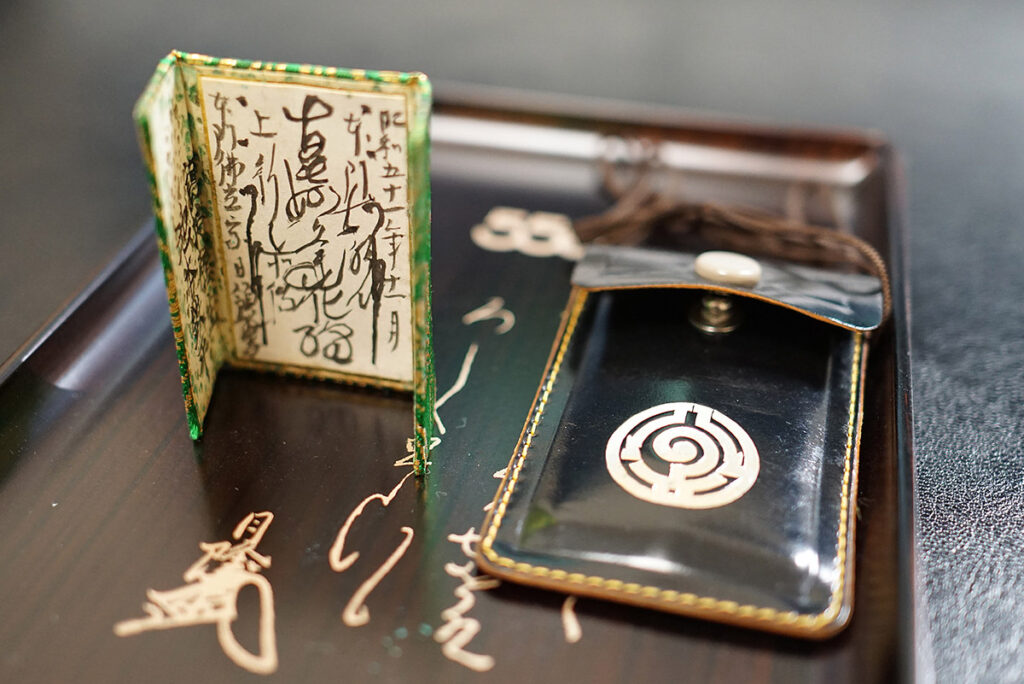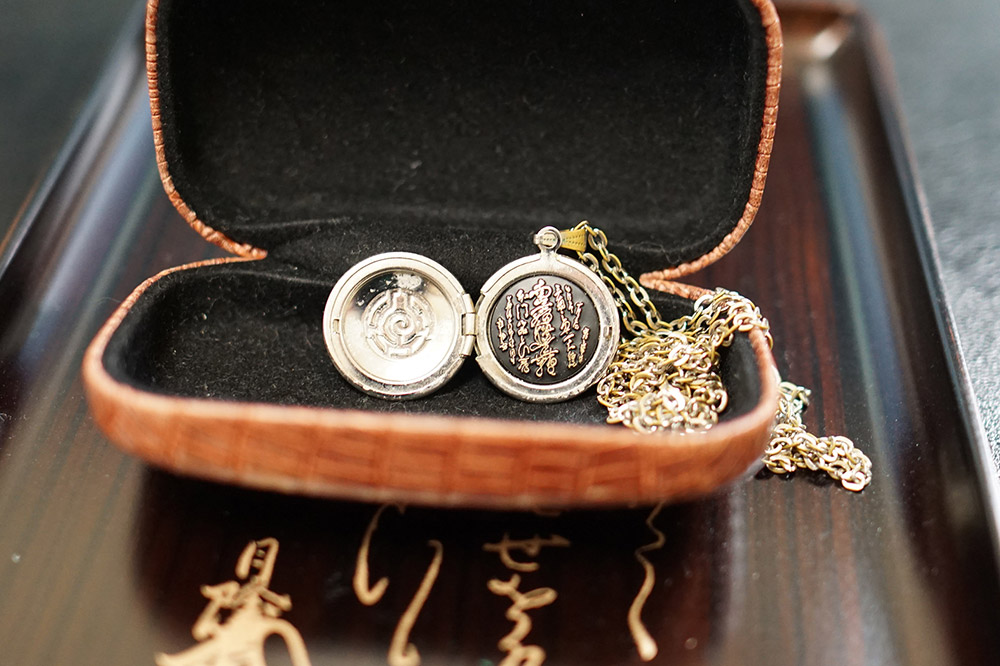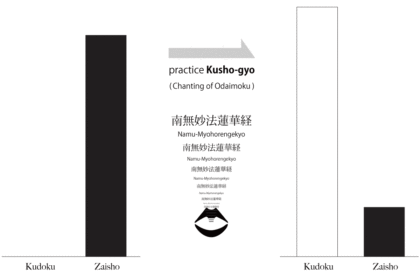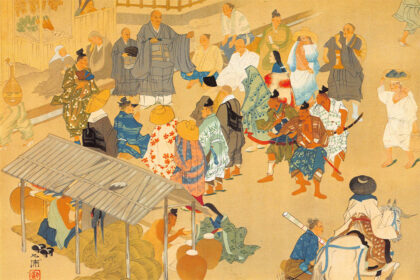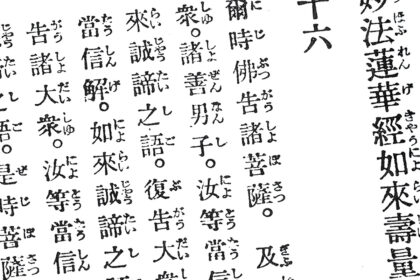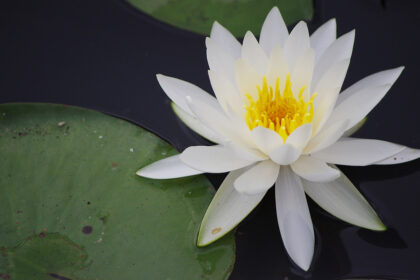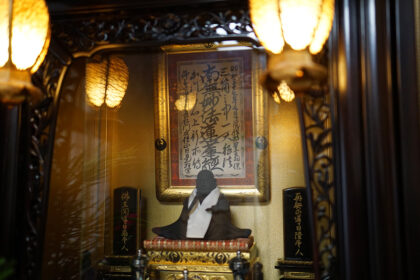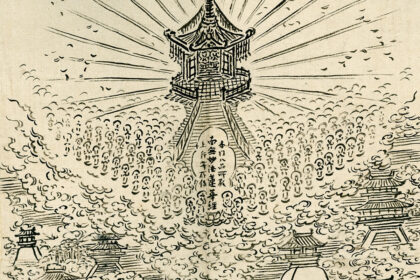Some time ago I received a query from Brazil about pocket (travel) Gohonzons, their shapes, and materials they can be made of, as well as qualifications required to draw and engrave a Gohonzon. So, I’ll just put all the answers here.
[ Types of pocket Gohonzon ]
There are a few types of pocket Gohonzon. The most standard one is made of paper. It’s folded and stored in a small leather case (as in the picture above). A locket pendant one in which a Gohonzon is stored is also popular, and recently there also appeared a necklace-type where Odaimoku, Namu Myōhō Renge Kyō is engraved directly on the surface of the pendant. It is said that Nichiren Shōnin gave portable Gohonzons to his followers in the form of small hanging scrolls or folded Japanese writing papers.
[ Small, but still Gohonzon ]
Basically, pocket Gohonzons are made so that followers can hold small Buddhist services and chant Odaimoku while traveling. As the name “pocket Gohonzon” suggests, they are small, but they don’t differ from the full-sized ones in any way, so you should treat your pocket Gohonzon the same way you treat the ones in temples or houses – i.e. like living Buddhas. Never treat your pocket Gohonzon improperly because of its small size. Respect shown to living Buddhas gives you the protection of the Lotus Sutra guardian deities.
[ Importance of Okujifubō ]
Nichiren Shōnin said in his treatise Nyosetsu Shugyō-Shō (如説修行抄 – On the True Way of Practicing the Buddha’s Teaching) that when abiding by the teaching of the Lotus Sutra in the Latter Day of the Law (Mappō period), his disciples and followers would face persecution from three kinds of enemies. “Abiding by the teaching of the Lotus Sutra” means “upholding the Odaimoku faith.” Upholding does not just mean enshrining a Gohonzon at home or carrying a pocket Gohonzon on you. It means Okujifubō (憶持不忘) – never forgetting the path and always practicing it. Having your pocket Gohonzon always with you makes you remember you are an Odaimoku practitioner and prevents you from behaving in a disgraceful way.
[ Recently popular necklace Gohonzons ]
Necklace pocket Gohonzons with the Odaimoku, Namu Myōhō Renge Kyō engraved directly on the pendant have been becoming popular both in Japan and abroad because people find them fashionable. Because of that people feel like wearing them all the time. However, that type of Gohonzon has to be carefully considered. All Gohonzons are basically living Buddhas. Can you imagine Buddha’s face getting stained with sebum or sweat or rubbing against your T-shirt’s fabric whenever you wear your pocket Gohonzon? Isn’t it rude to disrespect living Buddha in such a way? I cannot declare with all certainty which type of pocket Gohonzon is the most appropriate because there are no clear rules regarding that in our sect. However, in my own opinion, the most appropriate pocket Gohonzon should be the traditional type with paper stored in a case or the locket type because they show the wearer’s respect to Gohonzons, i.e. living Buddhas.
[ Materials ]
The old type pocket Gohonzon itself is made of paper, but materials of the case vary. I even saw someone with a knitted case before. My pocket Gohonzon’s case is made of leather, by the way. The materials which don’t corrode easily, such as gold, silver, or rhodium plating are usually used in locket Gohonzons because they are not affected by sweat. When we adorn the family altar at home, we do it to make Buddha’s living quarters more gorgeous. It is the same with the materials we choose for our pocket Gohonzon. This kind of thinking shows that you respect your pocket Gohonzon as a living Buddha. However, not everyone can pay for expensive precious metals, so it is not a problem to have a locket Gohonzon made of more affordable materials that are less durable if the Gohonzon itself is safely stored within the locket pendant.
Necklace type Gohonzons with Odaimoku engraved directly on the surface of the pendant should be made of durable materials resistant to corrosion such as gold or platinum, as the uncovered Gohonzon getting rusty is disrespectful to Buddha. Therefore please keep in mind that using expensive durable materials for your pocket Gohonzon is meant to show your respect toward the living Buddha, and not just to make your fashion accessory more beautiful.
[ Who can engrave Odaimoku ]
Only priests of master rank called Jōza (上座) or higher are allowed to create Gohonzon. They are used to calligraphing Odaimoku, Namu Myōhō Renge Kyō on Japanese writing paper using Chinese ink and a brush, so it does not take them much time or effort. However, when engraving Odaimoku on a tombstone or pendant, they usually have to ask an expert for assistance, as they may not have the necessary skills to work with stone or metal. In such case, the craftsman has to carefully copy Odaimoku written by a priest down to the tiniest detail (sometimes changing the size as required). The important point is that lower rank priests or lay people cannot write Odaimoku that will be regarded as Gohonzon. Lay craftsmen may only copy Odaimoku created by a priest.
[ How to obtain your own Gohonzon and start HBS practices ]
All Gohonzons must undergo a ritual called Kaigen (開眼 – Opening the Spiritual Eyes of the Lotus Sutra). Through the ritual, the material on which Odaimoku is written or engraved is imbued with the soul of the Lotus Sutra (Odaimoku), and then the item becomes a sacred Gohonzon (object of worship). Kaigen ritual must be performed in front of HBS Gohonzon enshrined in a temple.
People who want to receive their own Gohonzon, but are not yet HBS members, must first undergo a ritual in which they vow to abandon any other religion and remain faithful to Odaimoku from now on. Such promise is made in front of an HBS Gohonzon, which means it is a vow to Primordial Buddha, other Buddhas, and Bodhisattvas as well as the guardian deities of the Lotus Sutra. Kaigen ritual of the Gohonzon and Juzu (Buddhist prayer beads) that the person is supposed to receive is usually held on the same occasion, so the new practitioner will receive their Gohonzon and Juzu from the priest right after the ritual. It is just like a general Buddhist ceremony to receive precepts.
After these two rituals are completed, you can start HBS practices on your own and you will be under Buddha’s protection everywhere you go.
[ Why carry your pocket Gohonzon with you ]
Wearing a pocket Gohonzon means being under Buddha’s protection, as well as being in a constant state of Okujifubō. You should live up to your faith and treat your Gohonzon with respect by taking care of it properly and chanting Odaimoku.
All of the Buddha exists in the Treasure Tower of Namu Myōhō Renge Kyō.
Chapter 11 of the Lotus Sutra, The Emergence of the Treasure Tower

